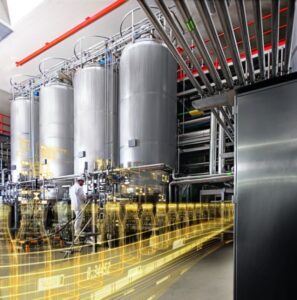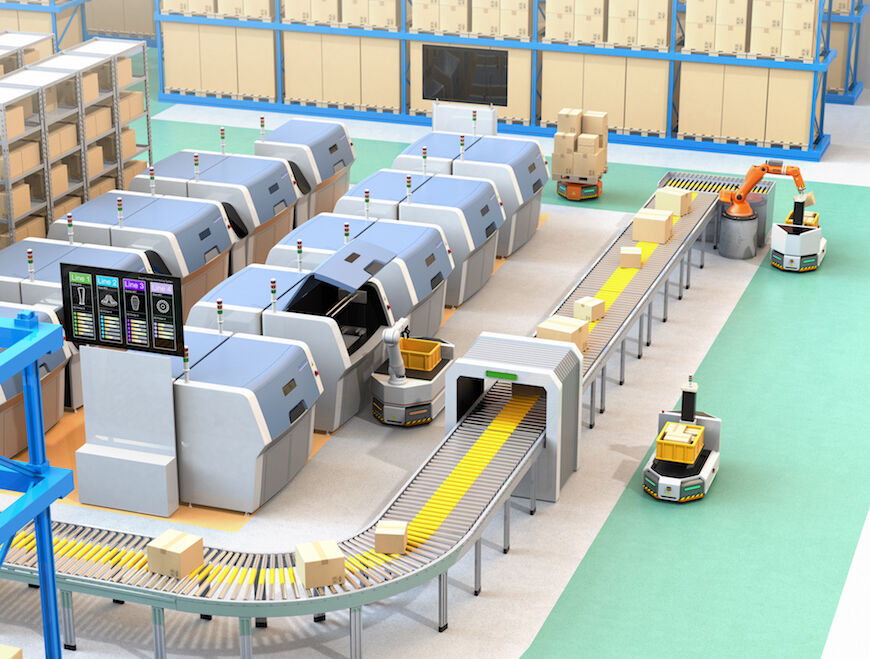We all know that manufacturing is a world in constant evolution. What happens inside most factories would be unrecognisable to the people who constructed those buildings decades ago. Those buildings, in turn, would be unrecognisable to the people who led industrialisation decades before that. It may sometimes seem, however, that reinventing production is constant. It’s not a smooth evolution but something the changes by fits and starts then great huge leaps. Those who don’t make the leap get left behind.
We are in the process of another leap forward in smart production design. Just as in product design and process design, a software system has arrived that can create an accurate digital twin of the production line. This digital twin can save companies months of production time and millions inunnecessary costs, as well as maintaining quality across the service life of the line. But for all its tangible benefits, it faces some intangible barriers to adoption.
A problem to be solved
Many new production lines are built in brown–field conversions. Factories that were designed to produce billions of units of a single product are now being modified into small-batch production lines. Sometimes even single production lines are being deployed to produce multiple products at the same time.
The flattening of the world through global trade and communications is now adding the requirement of agility. Where CP&R companies used to have three to four years for an innovation cycle, they nowhave three to four months. Instead of four launch windows a year, competitors are launching new products every other week. The rapid speed to market combined with the explosion of SKU’s numbers has made production line efficiency into not just a competitive differentiator but the difference between success and failure.
Production line optimisation maximises the use of every square inch in the factory to adapt that to new production needs. It starts with scanning the building to get a digital copy that will help redesignits usage and configuration. It then moves into the design of the new infrastructure, equipment and lines. Production line design software first optimises the set-up of the production line, then helps maintain it through the digital twin.
The production digital twin is in the centre of the manufacturing innovation. Through use of the digital twin, engineers can optimise how the lines work together. More importantly, it can be used to design the equipment of the line and the automation that runs the equipment. Production design optimisation through a digital twin can ensure each piece works smoothly and rapidly.

Industry and Internet of Things concept
The factory is too expensive to be used as a lab
The production line has historically been where theory meets reality. There are always variations in equipment or environmental conditions in a factory. The best equipment that suppliers can deliver has to be integrated in the lines. Some even refer to commissioning and integrating equipment into the line as an art rather than a science. More importantly, the weeks it takes to get equipment working is time that companies can no longer afford to spend.
The cost of commissioning, testing and validating each piece of equipment and their automation becomes exorbitant and a single problem on a line can be immensely expensive in time and resources.
With production design and optimisation, every new equipment or line tested within the digital twin. The equipment itself can be commissioned virtually. Once the supplier has designed and built the equipment, the company gets its digital twin from the supplier. The digital twin of the new machine or line can be integrated in the production digital twin of the factory. The new line configuration and production processes can be virtually tested validated before any physical resources are spent.
In fact, production design optimisation lays the groundwork for a smooth manufacturing process to get products faster to market. Factory and line simulations can increase overall equipment effectiveness and help to test different production configuration alternatives. The digital twin allows for accurate production scheduling.

What can you do with an ongoing digital twin?
The digital twin becomes even more valuable once production is ongoing. Companies with a digital twin of production have a key advantage in the plant service lifecycle. Service and maintenance operations can be performed more accurately and rely on the latest digital configuration of each piece of equipment, maintained in the digital twin.
A Production Digital Twin gives companies visibility across all plants and their production capabilities, this is a very important point when a company decides to scale up production of a product faster or to move production from one factory to another.
The cost of moving – and the price of not moving
Thought leaders across the industry have moved to virtual design and optimisation of their production lines and processes. The price for companies that don’t follow will be steep. As Bain Consultancy noted, “successful companies of future will operate with speed.” Companies that don’t trust virtual simulations and commissioning won’t have the speed to compete. They will face an existential threat if they don’t integrate digital twins to adapt quickly to changes in the market.
Production design optimisation is the most important thread. It used to be an option, but as speed and competition increase, it’s become a requirement for future success. That may mean a full cultural transformation in some companies, but it’s one they should embrace. The cost of not optimisingproduction design through a virtual twin is just too high.
Putting theory into practice
The most interesting example of the power of the production digital twin started more than a decade ago for a Swedish company with the goal to improve all their factories across the world. Electrolux isone of the world’s biggest white goods producers. The company owns and manufactures numerous brands, including Grand Cuisine, AEG, Zanussi, Frigidaire, and Westinghouse. Its acquisition of the white goods divisions and locations of the German company Daimler Benz brought into sharp relief the need to improve and standardise production across 46 sites.
When Electrolux teams began searching in 2010 for software that would lay the groundwork for its virtual manufacturing project, Siemens was one of the few companies whose system could handle 3D factory simulation and planning, which was one of the project’s prerequisites. As Siemens Teamcenter was deployed across Electrolux, the relationship between the companies’ teams prompted Electrolux to be both early adapter and partner of the newly developed 3D software line planner.
The results were stunning. Giovanni Pacini, the Global Director of Digital Industrial Operations described that the system became the central brain for the factories, feeding information back and forth across a complex system. Sensors in all of the factories transmit information to a central brain with alerts and data visualisations. Individual production sites or lines are not reacting individually to problems, but as part of a coordinated system whose shared information allows them to be proactive.
The changes are especially noticeable in the effects of the digital twin capabilities on factory planning. Electrolux’ engineers simulate everything before going into production. Nothing is installed until it has been tested and validated virtually within the digital twin. They try to improve not just the production lines but also the conditions for their employees. Electrolux simulates the workspace and materials, looking at the ergonomics of the operator.
Pacini described how production design optimisation through the virtual twin helped in the rollout of a new production line in Brazil. They pre-emptively testing solved 16 issues that they spotted in the digital twin. The real-world fixes would’ve created a six-month delay and cost half a million euros.
Ernesto Ferrario, the SVP of Global Industrial Operations, saw the monumental impact on planning. He noted that manufacturing capacity used to be calculated on an Excel sheet, with data input manually. The software simulation does more than automate this process; it finds process bottlenecks and helps identify how many people are needed at which stations. “Simulation does in one week what two engineers used to do in three months,” he noted. Planning the factory correctly on the first attempt helps secure the enormous investments companies make in them.
A perfect example is Electrolux’s refrigerator plant. The bottleneck was in the area where the walls are foamed with a hardening material. The process was mapped and simulated as a one-piece flow within the 3D Plant Simulation system. These results eliminated the need for larger buffers. The single conveyor and high-bay warehouse saved approximately two million dollars.
The digital twins have been used to standardise processes and streamline their factory buildings worldwide. Optimised production lines and piece of equipment are reused and replicated worldwide by simply adjusting the parameters. 3D simulations are used to avoid conflicts while maximisingresource use. Smart production planning has also allowed for a higher degree of automation, engineers can use the digital twin to identify the number of robots needed their role. They optimiseroutes to get any purchased parts swiftly and efficiently from the truck to the line.
Now that the plant is open, the digital twin has become a living tool for plant management. The one digital truth is shared across teams and platforms. It’s also constantly updated to allow managers to compare plans to reality. They can anticipate challenges and find problem areas by comparing expectations. They can easily reorganise work orders to respond to new needs and ongoing issues.The time for quality tests has also been reduced through data management. By using the digital twin to optimise testing points, times and batches, they are achieving a higher accuracy through fewer tests.
Electrolux estimates that they are getting products market up to 30% faster while benefiting from up to 20% lower cost of goods sold. The company’s forward-looking approach to optimising their production lines and standardising the results has literally paid dividends.
Author: By Benjamin Sheath, VP and Managing Director at Siemens Digital Industries Software


